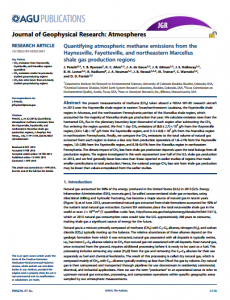Full Title: Quantifying Atmospheric Methane Emissions From the Haynesville, Fayetteville, and Northeastern Marcellus Shale Gas Production Regions
Author(s): J. Peischl, T. B. Ryerson, K. C. Aikin, J. A. de Gouw, J. B. Gilman, J. S. Holloway, B. M. Lerner, R. Nadkarni, J. A. Neuman, J. B. Nowak, M. Trainer, C. Warneke, and D. D. Parrish
Publisher(s): AGU Publications
Publication Date: March 1, 2015
Full Text: Download Resource
Description (excerpt):
We present measurements of methane (CH4) taken aboard a NOAA WP-3D research aircraft in 2013 over the Haynesville shale region in eastern Texas/northwestern Louisiana, the Fayetteville shale region in Arkansas, and the northeastern Pennsylvania portion of the Marcellus shale region, which accounted for the majority of Marcellus shale gas production that year. We calculate emission rates from the horizontal CH4 flux in the planetary boundary layer downwind of each region after subtracting the CH4 flux entering the region upwind. We find 1 day CH4 emissions of (8.0 ± 2.7) × 107 g/h from the Haynesville region, (3.9 ± 1.8) × 107 g/h from the Fayetteville region, and (1.5 ± 0.6) × 107 g/h from the Marcellus region in northeastern Pennsylvania. Finally, we compare the CH4 emissions to the total volume of natural gas extracted from each region to derive a loss rate from production operations of 1.0–2.1% from the Haynesville region, 1.0–2.8% from the Fayetteville region, and 0.18–0.41% from the Marcellus region in northeastern Pennsylvania. The climate impact of CH4 loss from shale gas production depends upon the total leakage from all production regions. The regions investigated in this work represented over half of the U.S. shale gas production in 2013, and we find generally lower loss rates than those reported in earlier studies of regions that made smaller contributions to total production. Hence, the national average CH4 loss rate from shale gas production may be lower than values extrapolated from the earlier studies.
